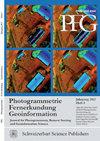MACS-TumbleCam - A Novel Approach for Aerial Oblique Imaging
Q Social Sciences
引用次数: 3
Abstract
The ATISS measurement drone, developed at the University of Applied Sciences Wildau, is an electrical powered autonomous motor glider with a maximum take-off weight of 25 kg including a payload capacity of up to 10 kg. Two engines enable ultra short take-off procedures and the motor glider design results in a 1 h endurance. The concept of ATISS is based on the idea to strictly separate between aircraft and payload functions, which makes it a very flexible research platform for miscellaneous applications. In a project together with German Aerospace Center (DLR) this carrier was used for demonstrating a novel approach in high-resolution digital terrain modelling. A lightweight, 3D-capable photogrammetric camera called MACS-TumbleCam was developed at the DLR Berlin especially for the ATISS payload concept. The unique feature of this camera system isthe special combination of two synchronized digital cameras with an adjustable relative alignment. One camera head is oriented in a fixed nadir position while the other one can be driven to variable oblique orientations by a robotic actuator. Thus it is possible to take images from very different view directions for almost every object on the ground. Due to a parametric boresight calibration a lowcost inertial orientation system can be used. The evaluation of the first test flights shows features of the system, i.e. derived high-precision 3Dmodels of urban structures with 3 cm ground pixel resolution and high-resolution facade textures.MACS-TumbleCam -一种新的航空倾斜成像方法
由威尔道应用科学大学开发的ATISS测量无人机是一种电动自主电机滑翔机,最大起飞重量为25公斤,有效载荷能力高达10公斤。两个发动机使超短的起飞程序和电机滑翔机的设计结果在1小时的耐力。ATISS的概念是基于严格分离飞机和有效载荷功能的想法,这使得它成为一个非常灵活的各种应用的研究平台。在与德国航空航天中心(DLR)合作的一个项目中,该航母被用于展示高分辨率数字地形建模的新方法。柏林DLR专门为ATISS有效载荷概念开发了一种名为MACS-TumbleCam的轻型3d摄影测量相机。这个相机系统的独特之处在于两个同步数码相机的特殊组合,具有可调节的相对对准。一个摄像机头定位在固定的最低点位置,而另一个摄像机头可以通过机器人执行器驱动到可变的倾斜方向。因此,从非常不同的视角为地面上几乎所有物体拍摄图像是可能的。由于参数化轴向校准,可以使用低成本的惯性定向系统。首次试飞的评估显示了该系统的特点,即导出了具有3厘米地面像素分辨率和高分辨率立面纹理的高精度城市结构3d模型。
本文章由计算机程序翻译,如有差异,请以英文原文为准。
求助全文
约1分钟内获得全文
求助全文
来源期刊

Photogrammetrie Fernerkundung Geoinformation
REMOTE SENSING-IMAGING SCIENCE & PHOTOGRAPHIC TECHNOLOGY
CiteScore
1.36
自引率
0.00%
发文量
0
审稿时长
>12 weeks
 求助内容:
求助内容: 应助结果提醒方式:
应助结果提醒方式:


